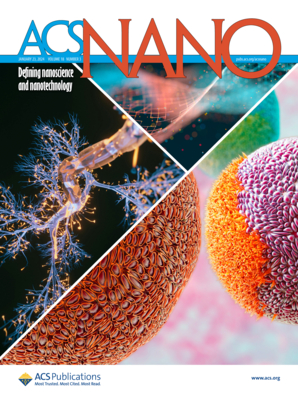Single-Dose Physically Cross-Linked Hyaluronic Acid and Lipid Hybrid Nanoparticles Containing Cyclic Guanosine Monophosphate–Adenosine Monophosphate Eliminate Established Tumors
IF 15.8
1区 材料科学
Q1 CHEMISTRY, MULTIDISCIPLINARY
引用次数: 0
Abstract
Activating the STING pathway in the cytosol of tumor-infiltrating antigen-presenting cells (APCs) represents a promising strategy to elicit potent antitumor immune responses for cancer therapy. However, STING agonists are mostly small hydrophilic molecules that suffer from rapid clearance and poor cytosolic delivery following systemic administration. While various nanoparticles have been developed to promote cytosolic delivery, they often exhibit premature drug release during circulation. Alternatively, stable nanoparticles with sustained release during circulation have poor cytosolic delivery. In this study, we have developed physically cross-linked hyaluronic acid (HA) and lipid hybrid nanoparticles containing cyclic guanosine monophosphate–adenosine monophosphate (cGAMP), denoted as HLHC, to address these challenges. The HLH delivery system has sustained drug release due to multiple lipid layers physically cross-linked by HA. HLHC efficiently delivers cGAMP to the cytosol of APCs, inducing more IFNβ than cGAMP and liposomal cGAMP. HLH also improves the drug circulation time and biodistribution to the tumor compared with the liposomal formulation and free drug. Strikingly, a single dose of HLHC, but not liposomal cGAMP or free cGAMP, elicits potent antitumor immunity and regresses established MC38 tumors. A single dose of HLHC even regresses established B16F10 tumors upon combination with αPD-L1. Moreover, cured animals were protected from rechallenge with the same tumor cells. HLHC represents an efficient strategy to address delivery challenges associated with STING agonists and may have broad applications for the delivery of drugs acting in the cytosol.

含有单磷酸环鸟苷-单磷酸腺苷的单剂量物理交联透明质酸和脂质杂化纳米粒子能消除已形成的肿瘤
激活肿瘤浸润性抗原递呈细胞(APCs)胞浆中的 STING 通路是一种很有前景的策略,可在癌症治疗中激发有效的抗肿瘤免疫反应。然而,STING 激动剂大多是亲水性小分子,全身给药后清除速度快,细胞膜传递能力差。虽然已开发出各种纳米颗粒来促进细胞给药,但它们往往会在循环过程中过早释放药物。另外,在循环过程中持续释放的稳定纳米颗粒的细胞给药效果也很差。在这项研究中,我们开发了物理交联透明质酸(HA)和脂质杂交纳米颗粒,其中含有单磷酸环鸟苷-单磷酸腺苷(cGAMP),称为 HLHC,以应对这些挑战。HLHC 给药系统通过 HA 物理交联的多层脂质实现了药物的持续释放。与 cGAMP 和脂质体 cGAMP 相比,HLHC 能有效地将 cGAMP 运送到 APC 的细胞质,诱导更多的 IFNβ。与脂质体制剂和游离药物相比,HLHC 还能改善药物在肿瘤中的循环时间和生物分布。令人震惊的是,单剂量 HLHC(而非脂质体 cGAMP 或游离 cGAMP)可激发强大的抗肿瘤免疫力,并使已形成的 MC38 肿瘤消退。单剂量HLHC与αPD-L1联用甚至能使已形成的B16F10肿瘤消退。此外,治愈的动物还能避免再次接触相同的肿瘤细胞。HLHC是解决与STING激动剂相关的给药难题的一种有效策略,可能会广泛应用于细胞质中药物的给药。
本文章由计算机程序翻译,如有差异,请以英文原文为准。
求助全文
约1分钟内获得全文
求助全文
来源期刊

ACS Nano
工程技术-材料科学:综合
CiteScore
26.00
自引率
4.10%
发文量
1627
审稿时长
1.7 months
期刊介绍:
ACS Nano, published monthly, serves as an international forum for comprehensive articles on nanoscience and nanotechnology research at the intersections of chemistry, biology, materials science, physics, and engineering. The journal fosters communication among scientists in these communities, facilitating collaboration, new research opportunities, and advancements through discoveries. ACS Nano covers synthesis, assembly, characterization, theory, and simulation of nanostructures, nanobiotechnology, nanofabrication, methods and tools for nanoscience and nanotechnology, and self- and directed-assembly. Alongside original research articles, it offers thorough reviews, perspectives on cutting-edge research, and discussions envisioning the future of nanoscience and nanotechnology.
 求助内容:
求助内容: 应助结果提醒方式:
应助结果提醒方式:


